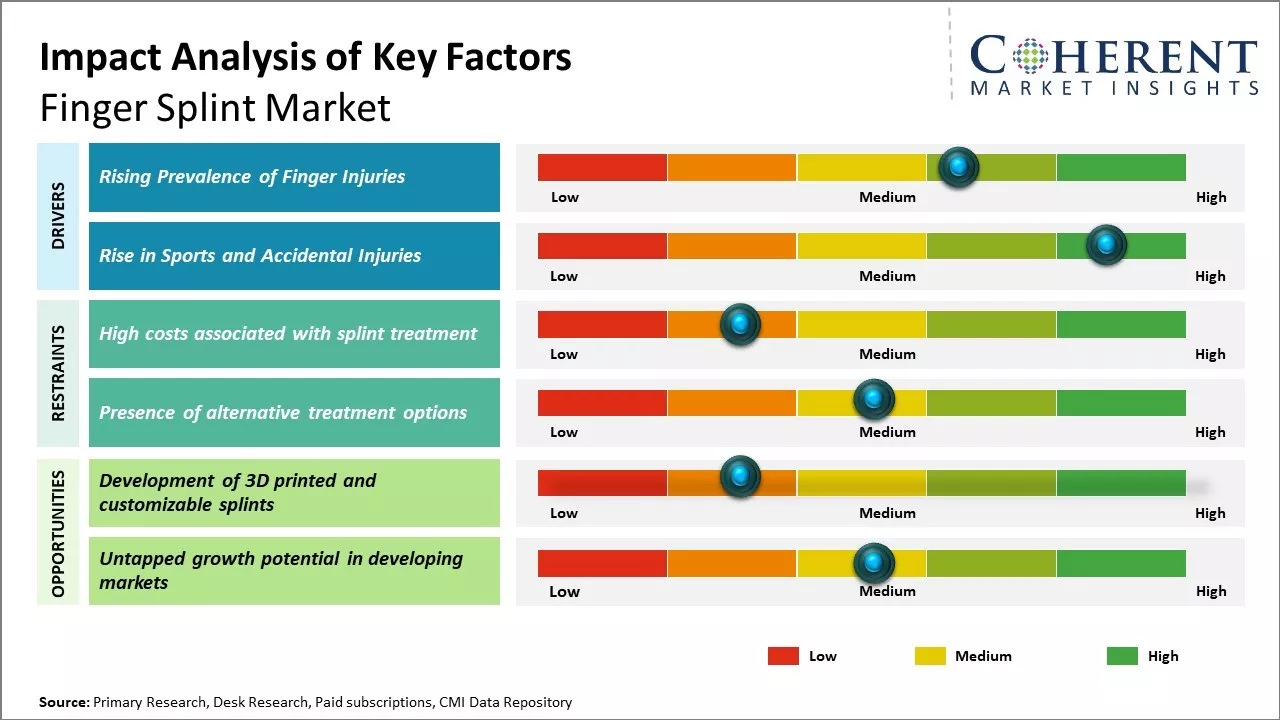Finger Splint Market Size and Trends
Global finger splint market is estimated to be valued at USD 188.1 Mn in 2025 and is expected to reach USD 310.2 Mn by 2032, exhibiting a compound annual growth rate (CAGR) of 7.4% from 2025 to 2032.

Discover market dynamics shaping the industry: Download Free Sample
Rising prevalence of arthritis and finger injuries can boost demand for finger splints. Finger splints help in immobilization of the affected finger joint and provide support, thus, facilitating faster healing. Moreover, growing participation in sports and adventurous activities have increased the risk of accidental finger injuries. Increasing healthcare expenditure and better access to healthcare services in developing countries can offer new growth opportunities for market players. However, availability of alternative treatments for finger injuries can hamper the market growth over the forecast period.
Rising Prevalence of Finger Injuries
With the fast-paced lives that many people lead in modern times, the instances of accidental injuries have increased substantially over the years. The hands are frequently used for a wide variety of tasks at work, home or during recreational activities, thus, placing the fingers at considerable risk of sustaining sprains, fractures and other forms of trauma. Whether it is due to falls, accidents during sports or vigorous physical work, minor disturbances during day-to-day chores or repetitive stress injuries, fingers can get hurt. For instance, in March 2023, according to a study published by Journal of Hand Surgery, the prevalence of finger injuries has increased significantly over the past decade. The study analyzed data from over 1,000 patients and found that the most common causes of finger injuries were falls, sports-related accidents, and repetitive stress injuries.
Market Concentration and Competitive Landscape

Get actionable strategies to beat competition: Download Free Sample
Rise in Sports and Accidental Injuries
Physical fitness and participation in sports or recreational activities has become increasingly popular worldwide over the past few decades. While an active lifestyle has tremendous health benefits, it also means a higher risk of orthopedic injuries. Sports that involve ball handling, climbing, biking, combat and contact are known to place extra stress on hands and fingers. Whether it is a jammed finger during basketball, a dislocated joint from yoga or a fractured bone in an accidental fall while trekking, injuries to the fingers are quite common in sports and adventure activities. Due to growing urbanization and mechanization of tasks, instances of accidental injuries at workplaces have been increased. Jobs involving assembly lines, construction, manufacturing, logistics, and others can leave workers vulnerable to crush injuries or amputations. Even domestic mishaps in homes like cuts from knives, burns from hot appliances or falls while gardening happens more frequently as per people’s medical reports. All these kinds of trauma frequently impact the delicate fingers and their structures.
Key Takeaways of Analyst:
Global finger splint market is expected to witness steady growth over the forecast period owing to rising incidence of finger injuries worldwide. The market growth is driven by growing participation in sports and outdoor recreational activities that involve risk of finger injuries. Moreover, increasing work-related accidents due to improper safety measures taken at construction sites and factories can boost demand for finger splints. However, the availability of alternative treatment options for minor finger injuries like taping and buddy strapping can hinder the market growth.
North America dominates the market due to rising healthcare expenditure and growing public awareness regarding finger injuries treatment in the region. Asia Pacific is expected to be the fastest-growing market due to the improving healthcare infrastructure and facilities in emerging countries.
Alternative material-based splints having advantages over conventional thermoplastics in terms of comfort, flexibility and lightweight nature can provide new opportunities for market players. Manufacturers are extensively focusing on developing 3D printed and customized splints to offer patients a better fitting as per the finger size and type of injury. However, lack of reimbursement policies for finger splints in many developing nations can hamper the market growth.
Market Challenges: High costs associated with splint treatment
The high costs associated with splint treatment can hamper the global finger splint market growth. Splint treatment involves both the cost of the splint itself as well as consultation and fitting charges from an orthopedic surgeon or physician. Finger splints can range anywhere from US$ 20 to US$ 100 per splint depending on the material used and complexity of design. A typical consultation with an orthopedic doctor to assess the injury, fit the splint properly and provide aftercare instructions can be US$ 100-300 without insurance in the U.S. alone. For many individuals and families globally, affording such out-of-pocket medical expenses for a finger injury, which may not be life-threatening, can be financially challenging. This is a major barrier to access timely splint treatment. According to the data published by World Bank in 2020, approximately 40% of the global population lacked access to essential healthcare services due to high out-of-pocket expenses. In low and middle-income countries like India, Indonesia, parts of Africa and Latin America, over 60-80% of healthcare costs are paid through direct payments from patients rather than insurance coverage.
Market Opportunities: Development of 3D printed and customizable splints
The development of 3D printed and customizable splints can offer a great opportunity for the global finger splint market. 3D printing technology allows splints to be precisely tailored to each individual patient's unique finger dimensions, shape, and injury. This level of customization was not possible before with traditional splint fabrication methods. 3D printed splints can be designed based on medical scans of the injured finger, ensuring a perfect fit that maximizes protection and comfort. The printing process also eliminates many production steps as compared to conventional splint-making, thus, reducing costs and manufacturing time. Splint that perfectly conforms to the natural contours of the finger is less likely to slip out of position or cause pressure points or irritation. This improves healing and facilitates a faster recovery. Precisely fitted splints also allow for a wider range of motion during rehabilitation exercises. The benefits of customized 3D printed splints could lead to their increased usage not just for acute finger injuries but also for conditions like arthritis where custom splints provide long-term comfort and support.

Discover high revenue pocket segments and roadmap to it: Download Free Sample
Insights, By Product Type: Rising prevalence of accidental injuries boosts demand for rigid splints
In terms of product type, rigid splint segment is estimated to contribute the highest market share of 25.6% in 2025, owing to their high effectiveness in immobilizing fingers during recovery from accidents and fractures. Rigid splints provide superior stability and are widely preferred by medical professionals and patients for conditions involving bone fractures, dislocations or post-surgery immobilization needs. Their rigid yet adjustable design allows for proper alignment of injured fingers while preventing unwanted movements. This is extremely important during the healing phase to ensure bones and tissues heal correctly.
Insights, By Material: Material comfort drive preference for neoprene splints
In terms of material, neoprene segment is estimated to contribute the highest market share due to its soft, flexible and comfortable properties. Neoprene splints conform well to the natural shape of fingers without causing pressure points or skin irritation. Their elastic and breathable material helps to reduce swelling and provide relief from pain. The gentle compression aids in blood circulation while supporting the injured area. This makes neoprene a preferable choice among patients needing to wear splints for extended periods during recovery.
By End User: Hospital convenience boosts demand from clinical setting
In terms of end user, hospitals segment is estimated to contribute the highest market share as these offer convenient access to medical supervision and management of injury cases. Injured patients, especially those with fractures or post-surgery needs, prefer visiting hospitals where splint application and dressing changes can be properly monitored by doctors and nurses. Hospitals also stock a wide range of clinically-approved splint designs from major brands to suit different injury types. This 'one-stop-shop' convenience drives a large percentage of splint demand through the hospital sector.
Regional Insights

Need a Different Region or Segment? Download Free Sample
North America dominates the global finger splint market with estimated market share of 40.7% in 2025. This can be attributed to high awareness levels about such medical devices and their importance in treating hand injuries. With technological advancements and presence of several major manufacturers, accessibility of high-quality finger splints is extremely high across hospitals and retail pharmacies in the region.
The U.S. alone accounts for over 40.5% of total regional market share, owing to advanced healthcare infrastructure and availability of favorable reimbursement policies for upper extremity injuries. Leading players from the region also have a strong distribution network within Canada and Mexico, enabling easy access to their products. Moreover, trade agreements like NAFTA have ensured steady supply chains within North America, keeping prices affordable.
Asia Pacific region has emerged as the fastest growing market for finger splint. Countries like China, India and Japan are witnessing rapid economic and industrial development. There has been rising incidence of hand injuries, surgeries and demand for supporting medical devices.
Market Report Scope
Finger Splint Market Report Coverage
| Report Coverage | Details | ||
|---|---|---|---|
| Base Year: | 2024 | Market Size in 2025: | USD 188.1 Mn |
| Historical Data for: | 2020 To 2024 | Forecast Period: | 2025 To 2032 |
| Forecast Period 2025 to 2032 CAGR: | 7.4% | 2032 Value Projection: | USD 310.2 Mn |
| Geographies covered: |
|
||
| Segments covered: |
|
||
| Companies covered: |
3M, BSN Medical, Patterson Medical, DJO Global, Zimmer Biomet, Stryker, Smith & Nephew, Mueller Sports Medicine, Brownmed, Össur, Mabis Healthcare, Acu-Life (Health Enterprises, Inc.), Alimed, DeRoyal Industries, Orfit Industries, Tynor Orthotics Private Limited, Sam Medical Products |
||
| Growth Drivers: |
|
||
| Restraints & Challenges: |
|
||
Uncover macros and micros vetted on 75+ parameters: Get instant access to report
Finger Splint Industry News
- In September 2022, Field Orthopaedics, a medical device company, announced a global distribution partnership with Medartis Inc, a specialized orthopedic company focused on head and extremity surgery. This strategic alliance will integrate Field Orthopaedics' NX Nail system into Medartis' extensive hand portfolio, expanding the product's global distribution reach and fostering growth opportunities in international markets.
- In September 2021 , Dassiet , a health-tech company, launched UCAST, a new splint aiming to revolutionize fracture treatment in hospitals. The thermoplastic UCAST cast takes only five minutes to apply as compared to traditional casts that can take up to 30 minutes. Made of non-allergenic and non-toxic materials, UCAST is lightweight, breathable, and comfortable for patients. Crafted from the wood composite material Woodcast, it ensures safety and ease of application. UCAST eliminates the need for measuring, cutting, and cleanup, streamlining fracture treatment.
*Definition: Global Finger Splint Market involves the manufacturing and sales of finger splints. Finger splints are medical devices used to immobilize and support injured fingers. These help promote healing of strains, sprains, fractures and other finger injuries by preventing movement at the injured joint. The market covers companies that design, develop and distribute different types of finger splints made from materials like thermoplastics, aluminum and various foams for uses like post-operative immobilization, ligament injuries and arthritis.
Market Segmentation
- Product Type Insights (Revenue, USD Mn, 2020 - 2032)
- Rigid Splint
- Flexible Splint
- Immobilization Splint
- Stress Splint
- Post-surgical Splint
- Others
- Material Insights (Revenue, USD Mn, 2020 - 2032)
- Neoprene
- Thermoform
- Soft Fabric
- Hard Plastic
- Metal
- Others
- End User Insights (Revenue, USD Mn, 2020 - 2032)
- Hospitals
- Clinics
- Home Care Settings
- Physiotherapy Centers
- Others
- Regional Insights (Revenue, USD Mn, 2020 - 2032)
- North America
- U.S.
- Canada
- Latin America
- Brazil
- Argentina
- Mexico
- Rest of Latin America
- Europe
- Germany
- U.K.
- Spain
- France
- Italy
- Russia
- Rest of Europe
- Asia Pacific
- China
- India
- Japan
- Australia
- South Korea
- ASEAN
- Rest of Asia Pacific
- Middle East
- GCC
- Israel
- Rest of Middle East
- Africa
- South Africa
- North Africa
- Central Africa
- North America
- Key Players Insights
- 3M
- BSN Medical
- Patterson Medical
- DJO Global
- Zimmer Biomet
- Stryker
- Smith & Nephew
- Mueller Sports Medicine
- Brownmed
- Össur
- Mabis Healthcare
- Acu-Life (Health Enterprises, Inc.)
- Alimed
- DeRoyal Industries
- Orfit Industries
- Tynor Orthotics Private Limited
- Sam Medical Products
Share
Share
About Author
Manisha Vibhute is a consultant with over 5 years of experience in market research and consulting. With a strong understanding of market dynamics, Manisha assists clients in developing effective market access strategies. She helps medical device companies navigate pricing, reimbursement, and regulatory pathways to ensure successful product launches.
Missing comfort of reading report in your local language? Find your preferred language :
Transform your Strategy with Exclusive Trending Reports :
Frequently Asked Questions
EXISTING CLIENTELE
Joining thousands of companies around the world committed to making the Excellent Business Solutions.
View All Our Clients
